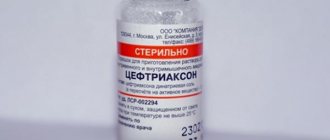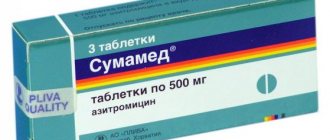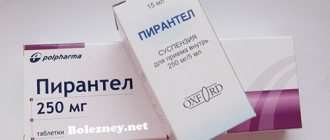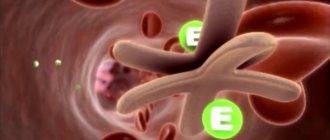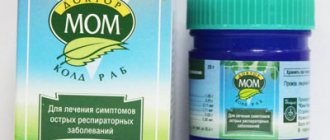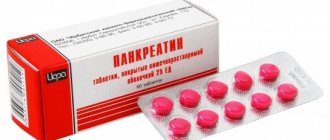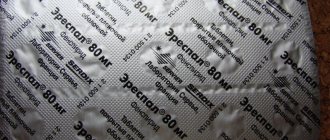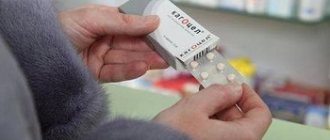Vilprafen Solutab is an antibacterial agent of the macrolide group. The correct treatment regimen with the drug gives a lasting bactericidal effect. The effect on the microflora of the gastrointestinal tract is minimal. A distinctive feature of the drug is that resistance of pathogenic microorganisms to its active substance is extremely rare.
Prices for the drug and main analogues
Vilprafen is a fairly expensive drug; 10 tablets of 500 mg each cost buyers 500-600 rubles. Vilprafen Solutab is even more expensive, the price for the drug starts from 700 rubles and above. Prices for the most well-known analogues of the drug are presented in the table.
| A drug | Price (in rubles) |
| Zitrolide 0.5g, No. 3 | 310 |
| Azithromycin 0.25g, No. 6 | 35 |
| AzitRus forte 500 mg, No. 3 | 135 |
| Sumatrolide Solution Tablets 250 mg, No. 6 | 269 |
| Roxithromycin 0.15g, No. 10 | 166 |
| Clarithromycin-OZONE 500 mg, No. 5 | 106 |
| Sumamed tablets p.p.o. 125 mg, No. 6 | 237 |
| Ziomycin 250 mg, No. 6 | 210 |
| Macropen tab. 400 mg, No. 16 | 226 |
| Clubax OD tab. prolong p/o 500 mg, No. 7 | 252 |
| Sumamed forte powder for suspension, 200mg/5ml bottle | 320 |
| Azibiot 200mg/5ml | 259 |
Dosage for adults
This drug is prescribed only by a doctor, and the dosage must correspond to the diagnosis.
For adults, 1-2 g is recommended. This amount is distributed throughout the day (500 mg each). Treatment lasts from 5 to 21 days, it all depends on the inflammatory process.
When treating mycoplasmosis, 0.5 g per day is recommended for two weeks.
When treating skin diseases, you should take 0.5 g 2 times a day for 2-4 weeks, and then 0.5 g 1 time a day for eight weeks to consolidate the result.
For the treatment of streptococcal infections, therapy lasts at least 10 days.
In the case of treatment of Helicobacter pylori, you should take 1 to 2 g of antibiotic per day for one to two weeks in combination with other drugs.
Pyoderma – 500 mg, course 10 days, 2 tablets per day.
Chronic periodontitis - 500 mg 2 times a day, course - 12-14 days.
Reviews of Vilprafen 500 for children should be read in advance.
Indications for use
The microbiology of the drug is quite extensive; Vilprafen exhibits antibacterial activity against:
- gram-positive prokaryotes of the Streptococcaceae and Corynebacterium families;
- gram-negative diplococci, pathogens of gonorrhea (N.gonorrhoeae) and meningococcal infection (N. meningitidis);
- gram-negative obligate cell parasites - chlamydia (trachomatis and C. pneumoniae) and ureaplasma (U. urealyticum);
- bacteria that have lost their cell wall - mycoplasmas (M. pneumoniae, M. hominis);
- gram-negative rod-shaped legionella (L. pneumophila), belonging to pathogenicity group II;
- gram-negative Pfeiffer bacilli (H. influenzae) - causative agents of hemophilic inflammatory processes and Bordet-Gengou bacterium (B. pertussis) - causative agents of whooping cough;
- anaerobic prokaryotic cells - peptococci, peptostreptococci and clostridia.
Contraindications for use
The drug should not be used:
- if there is hypersensitivity to josamycin or any other component included in the composition;
- there were allergic reactions to macrolide antibiotics;
- have liver disease;
- premature babies.
This must be taken into account before making an appointment.
Pharmacological effect
The bactericidal effect of the active substance of the drug is due to the fact that josamycin is able to bind to the large subunit of the ribosomal membrane (50S), prevents the fixation of transport RNA, and also blocks the translocation of A-center peptides (a type of mutation that is accompanied by chromosomal rearrangement that affects the properties of the cell) and suppresses the intracellular production of proteins from amino acids.
The spectrum of action of josamycin, which is part of Vilprafen, is quite wide.
The substance is active against gram-positive aerobic microorganisms, including:
- Peptococci secreted by the body during inflammatory processes;
- Peptostreptococci, which provoke the development of mixed infections;
- Staphylococcus;
- The causative agent of anthrax is anthrax bacillus;
- Bacteria of the genus Corynebacterium, which are the causative agents of diphtheria;
- Clostridium perfringens – causative agents of gas gangrene and toxic infections in humans;
- Streptococci.
Vilprafen is also active against gram-negative microorganisms, including:
- Hemophilus, which is the cause of hemophilus infections, including purulent meningitis, acute pneumonia, pericarditis, septicemia, etc.;
- Neisseria, which are the causative agents of diseases such as gonorrhea and meningitis;
- Some varieties of Shigella, which provokes the development of dysentery;
- Bacteroides fragilis, which are causative agents of purulent-infectious diseases that develop after injuries, surgical interventions, immunodeficiency, etc.;
Josamycin also has activity against various intracellular parasites: chlamydia, legionella, mycoplasma, ureaplasma.
How does the medicine work?
In accordance with the instructions, the antibacterial effect of taking Vilprafen and Vilprafen Solutab is aimed at inhibiting the reproduction of microbes, which manifests itself in the form of a bacteriostatic effect. In order to exert a bactericidal effect (death of pathogenic microorganisms), a maximum concentration of the active substance is required directly in the inflamed area.
After oral administration, the drug is quickly and fully absorbed; food does not actually reduce the bioavailability of the drug. During preclinical tests on pregnant animals, penetration of the active component into breast milk and a high level of permeability of the hemato-placental threshold were noted.
Treatment of ureaplasma
The constant presence of ureaplasma in the body is not typical for a healthy person. These are bacteria without a cell membrane and DNA, slightly larger than viruses. Habitat: mucous membranes of the human genitourinary tract. Under certain circumstances, inflammation of the mucous membrane occurs. This infection is transmitted sexually, and if a woman was sick before pregnancy, then there is a high chance of infecting the newborn during childbirth. Therefore, doctors recommend that both sexual partners undergo treatment at the same time, and preferably before planning a pregnancy.
According to reviews, “Vilprafen 500” quickly helps with ureaplasma. It is the best in the fight against the microbe Ureaplasma urealyticum. Women are additionally prescribed medications to restore the flora of the intimate area. The course of treatment is at least 10 days, it consists of the following:
- Taking Vilprafen 500 should start with 0.5 g three times a day or 1 g twice a day. To maintain therapeutic concentrations, the antibiotic is used every 8-12 hours. If you miss taking a medicine, the dose is not increased.
- In addition to antibiotic therapy, women include Hexicon vaginal suppositories before bed; men are recommended to rinse the urethra with Hexicon solution. Additionally, women can use Vaginorma S or Ginolakta suppositories to restore the vaginal microflora.
- On the 1st and 5th day, women are recommended to take antifungal suppositories (“Polygynax”).
- To reduce the effect of the drug on the liver, use “Karsil” one capsule 3 times a day. "Vilprafen 500" does not have a strong effect on the gastrointestinal tract. But gastroenterologists recommend taking a course of probiotics, for example, Linex or Bifilax, together with antibiotics. This will only be beneficial.
Also, do not forget about taking multivitamin complexes and immunomodulators.
During treatment, it is better to completely give up smoking, alcohol, spices, salty and spicy foods. It is recommended to avoid sexual intercourse.
After 2 weeks after the course of treatment, it is necessary to be tested for the presence of the pathogen. Moreover, both partners undergo the examination.
Directions for use and dosage
In order to use the medicine correctly, you should first read its instructions, which stipulate the dosage and duration of treatment for various diseases. The prescription in each specific situation is made by the doctor, taking into account the diagnosis and general condition of the patient. The duration of the treatment course is usually from 5 to 25 days. This antibiotic is taken according to the following rules:
- The daily dose is up to 2 milligrams, and in the presence of severe disease it increases to 3 milligrams.
- The entire amount of the drug is taken in two or three doses.
- In order to achieve the required concentration, it is advisable to use the medicine between meals.
- The tablet can be swallowed, followed by some liquid.
- As part of the preparation of the liquid composition, the tablet is dissolved in a spoonful of water, after which the medicine is thoroughly mixed.
- In order to achieve a complete recovery, you should not take breaks in treatment.
Drug interactions
- Vilprafen inhibits the elimination of xanthines, which can provoke the development of intoxication.
- It is recommended to avoid the simultaneous use of Vilprafen with other antibiotics. This may reduce their effectiveness.
- Concomitant use of an antibiotic with cyclosporine may lead to an increase in the concentration of the latter, so its level should be monitored throughout treatment.
- Taking Vilprafen may reduce the effectiveness of hormonal contraceptives, therefore, in order to avoid unwanted pregnancy, it is recommended to additionally use non-hormonal contraceptives.
- The combined use of Vilprafen with antihistamines, including astemizole and terfenadine, increases the concentration of the latter, which can lead to the development of serious cardiac arrhythmias that are life-threatening.
Interaction with other drugs
– other antibiotics
Since bacteriostatic antibiotics in vitro can reduce the antimicrobial effect of bactericidal ones, their coadministration should be avoided. Josamycin should not be prescribed together with lincosamides, as a mutual decrease in their effectiveness is possible.
– xanthines
Some representatives of the macrolide group slow down the elimination of xanthines (theophylline), which can lead to signs of intoxication. Clinical and experimental studies indicate that josamycin has less effect on the elimination of theophylline than other macrolides.
– antihistamines
When josamycin is co-administered with antihistamines containing terfenadine or astemizole, the risk of life-threatening arrhythmias may increase.
– ergot alkaloids
There are isolated reports of increased vasoconstriction after co-administration of ergot alkaloids and macrolide antibiotics, including a single observation while taking josamycin.
– cyclosporine
Co-administration of josamycin and cyclosporine may cause increased plasma levels of cyclosporine and increase the risk of nephrotoxicity. Plasma concentrations of cyclosporine should be regularly monitored.
– digoxin
When administered together, josamycin and digoxin may increase the level of the latter in the blood plasma.
special instructions
In the case of persistent severe diarrhea, one should keep in mind the possibility of life-threatening pseudomembranous colitis developing against the background of josamycin.
In patients with renal failure, treatment should be carried out taking into account the results of appropriate laboratory tests (determination of endogenous creatinine clearance).
The possibility of cross-resistance to various macrolide antibiotics should be taken into account (microorganisms resistant to treatment with antibiotics related in chemical structure may also be resistant to josamycin).
Impact on the ability to drive vehicles and operate machinery
There was no effect of the drug on the ability to drive vehicles.
means and work with mechanisms.
Release form
Film-coated tablets 500 mg.
10 tablets in an aluminum/PVC blister. 1 blister along with instructions for use is placed in a cardboard box.
Best before date
4 years.
Vilprafen should not be used after the expiration date indicated on the package.
Storage conditions
Store at a temperature not exceeding 25 ° C in a place protected from light.
Keep the medicine out of the reach of children!
Conditions for dispensing from pharmacies
Dispensed with a doctor's prescription
Registration applicant (RU owner)
Astellas Pharma Europe B.V., Elisabethof 19, 2353 EB Leiderdorp, The Netherlands /
AstellasPharmaEuropeB.V., Elisabethhof 19, 2353 EWLeiderdorp, TheNetherlands.
Vilprafen solutab instructions for use
Adult patients are advised not to crush or chew the tablet, but to swallow it whole with water one hour before a meal or three hours after a meal. An interval of 12 hours (plus or minus one hour) must be maintained between taking tablets, otherwise the effectiveness of treatment will decrease. Instructions for using Vilprafen for children suggest dissolving the drug in a glass of water, stirring well and drinking.
Vilprafen during pregnancy
Domestic medicine does not prohibit the use of this bactericidal agent during pregnancy, but only if the benefits of the medicine exceed its harmful effects on the child. For ureaplasma, gynecologists often prescribe treatment with Vilprafen, because the infection can harm the mother and baby more than taking antibiotics. The price of the medicine is low and accessible to everyone.
Before pregnant or young mothers during lactation start taking Vilprafen, it is necessary to carefully study the instructions and become familiar with the side effects of the drug. It can be prescribed from the first trimester of pregnancy (from the tenth week), however, many experts believe that the drug should be included in the treatment regimen no earlier than the fetus is formed (from the twentieth week of pregnancy). If the patient begins to feel nausea and vomiting after taking the medicine, you should stop taking it.
Vilprafen for men with ureaplasma
If a man feels continuous pain in the genital area, and every trip to the toilet causes discomfort, and discharge is observed during urination, a ureaplasma infection may be diagnosed. It must be treated immediately so as not to provoke the development of prostatitis and infertility. To combat the acute form of the disease, antibiotic therapy is used; for chronic ureaplasmosis, complex treatment is required. Vilprafen for men is used in the treatment of this infection according to the general scheme.
Contraindications
The main contraindication is the patient's hypersensitivity to josamycin, as well as to antibiotics with macrolide action. The drug is not prescribed to premature babies and those weighing less than ten kilograms, with disorders of the liver gland.
During pregnancy, you should use the medicine carefully in the first three months. During treatment, breastfeeding should be stopped. The medicine crosses the placental barrier and is absorbed into milk. For sexually transmitted diseases, therapy with josamycin is prescribed; it affects the body of the mother and the unborn child.
What is ureaplasmosis
In modern specialized literature, the disease is literally called “ureaplasma infection.” It covers the genitourinary system, can occur in both men and women, and is often diagnosed in children. Ureaplasma often lives in the body with other harmful microbes, for example, chlamydia. They are cured with the same drugs. Treatment of ureaplasmosis with antibiotics not related to the tetracycline series is especially effective.
Several internal and external factors can contribute to the development of the disease. These include low immunity in women, the presence of other diseases or infections of the genitourinary system or infections. Women who frequently change sexual partners are especially at risk of infection with microorganisms. Children, as a rule, become infected during childbirth from their mother. Ureaplasma in young girls who are not sexually active is extremely rare.
Effect on the body
Let's consider the effect of "Josamycin" on pathogenic microorganisms. The active component of the drug can inhibit the formation of proteins in bacteria. In medium doses, this medicine suppresses and stops the proliferation of pathogenic microflora. A high concentration of antibiotic leads to the death of pathogens.
The drug affects the following types of microorganisms:
- streptococci;
- pneumococci;
- staphylococci;
- diphtheria and hemophilus influenzae;
- gonococci;
- Treponema pallidum;
- chlamydia;
- mycoplasma;
- ureaplasma;
- clostridia;
- Helicobacter pylori.
Unlike many other antibiotics, Josamycin does not destroy beneficial microorganisms living in the gastrointestinal tract. Taking this drug does not lead to the development of dysbacteriosis.
The active component of the drug is quickly absorbed into the blood. Its highest concentration in the body is observed after 1 hour. The antibiotic has a long-lasting effect. It is excreted from the body mostly through the intestines along with bile.
Instructions for use
The instructions for use indicate that the recommended dose for adults and adolescents over 14 years of age is 1-2 g in 2-3 divided doses. The initial recommended dose is 1 g.
- For the treatment of rosacea - 500 mg 2 times a day for 10-15 days.
- For the treatment of pyoderma - 500 mg 2 times a day for 10 days.
- For the treatment of urogenital chlamydia - 500 mg 2 times a day for 12-14 days.
- For the treatment of chronic periodontitis, with abscessation of the periodontal bone - 500 mg 2 times a day for 12-14 days.
- For common and spherical (conglobate) acne, 500 mg 2 times a day is prescribed for the first 2-4 weeks, then 500 mg 1 time a day as maintenance therapy for 8 weeks.
The tablets should be swallowed without chewing, with a small amount of liquid, between meals. Usually the duration of treatment is determined by the doctor. In accordance with WHO recommendations on the use of antibiotics, the duration of treatment for streptococcal infections should be at least 10 days.
Infants and children under 14 years of age are preferably prescribed the drug in the form of a suspension. The daily dose is 30-50 mg/kg body weight, divided into 3 doses. In newborns and children under 3 months of age, the dose should be adjusted according to the exact body weight of the child.
The bottle of suspension must be shaken before use.
special instructions
If severe diarrhea occurs during therapy, the possibility of developing pseudomembranous colitis as a result of taking an antibiotic cannot be ruled out. In this case, the use of Vilprafen Solutab should be stopped and appropriate treatment should be completed. Medicines that reduce intestinal motility are contraindicated.
In people with renal failure, constant monitoring of renal function and dosage adjustment are required in accordance with endogenous creatinine clearance values.
Microorganisms that are resistant to treatment with antibiotics of a similar chemical structure may be resistant to josamycin.
The medication is not used for premature babies.
How to replace Vilprafen Solutab
There are very few analogues of Vilprafen Solutab on the market. Of these, Azibiot and Sumamed Forte are most often used.
Azibiote
Azibiot is an azalide antibiotic similar to AzitRus. Available in the form of a lyophilisate for the preparation of infusions. It is used for bacterial infections of the upper and lower respiratory tract, urogenital tract, skin, as well as gastritis, gastroduodenitis and Lyme disease. Prescribed orally 0.25-1 g one hour before meals. Not for use in children under 16 years of age, pregnant or lactating women, patients with severe hepatitis, liver necrosis and hypersensitivity. May cause:
- headache;
- noise in ears;
- hyperkinesis;
- drowsiness;
- cardiopalmus;
- candidiasis;
- liver failure;
- hives;
- nephritis;
- liver necrosis;
- anxiety, drowsiness, aggressiveness.
Do not use with digoxin, phenytoin, ergot alkaloids.
Sumamed Forte
Sumamed Forte is an antimicrobial drug that is available in the form of a yellowish-white powder. It is well absorbed, distributed throughout the body, and large doses of the drug accumulate in the tissues.
The drug is prescribed once a day, an hour before meals, at a dose of 10 mg/kg for 3 days. To be prescribed, the patient's weight must be more than 10 kg. Side effects are relatively rare and include activation of liver enzymes, decreased platelet levels, nausea, rash and gastrointestinal disorders.
Cost and analogues
The cost of Vilprafen (dosage – 500 mg) in Russia starts from 525 rubles. Tablets of 1000 mg cost on average from 650 rubles.
There are no complete analogues of the drug in modern pharmacology. The active substance josamycin is present only in Vilprafen. In critical situations, such as intolerance to the components of the drug, antibacterial agents with a similar effect can be used:
- Erythromycin. Available in the form of ointment, tablets, lyophilisate for preparing a solution. The advantages of this product include an affordable price, a minimum of adverse reactions and ease of use, while the disadvantages include low efficiency.
- Clarithromycin. Available in the form of capsules and tablets. One of the advantages is better absorption by the body. The downside of the drug is its effect on the patient’s nervous system.
- Spiramycin-Vero. Available in the form of tablets, sachets for the preparation of suspension and infusion solution. This remedy is better suited for the treatment of diseases of the ENT organs. It has the most similar effect to Vilprafen. Disadvantages: severe adverse reactions.
The use of any of the listed substitute drugs should be accompanied by a comprehensive examination by a doctor. If alarming symptoms occur, seek medical help immediately and stop using the medication.
Loading…
Share with friends!
Instructions for use
The instructions for use indicate that Vilprafen Solutab dispersible tablets can be taken whole, washed down with liquid, or immediately before use, dissolved in water (at least 20 ml) and thoroughly stirred the resulting suspension. The last option is most suitable for children, especially small ones.
- For adults and adolescents over 14 years of age, the drug is prescribed in a daily dosage of 1000–2000 mg in 2-3 doses. In severe cases of the infectious process, it is possible to increase the dose to 3000 mg per day.
- The daily dose for children weighing at least 10 kg (usually from 1 year) is calculated based on weight: 40–50 mg/kg in 2–3 divided doses.
Thus, depending on body weight, children are prescribed:
- from 10 to 20 kg – 250–500 mg of josamycin (¼–½ tablet) 2 times a day;
- from 20 to 40 kg – 500–1000 mg (½–1 tablet) 2 times a day;
- more than 40 kg – 1000 mg (1 tablet) 2 times a day.
The duration of therapy is determined by the doctor; depending on the indications and course of the disease, it can be 5–21 days. According to the recommendations of the World Health Organization (WHO), it takes at least 10 days to completely cure streptococcal tonsillitis.
For diseases of the gastrointestinal tract associated with the bacterium Helicobacter pylori, Vilprafen Solutab is prescribed at a dose of 1000 mg 2 times a day for 7–14 days in addition to one of the standard anti-Helicobacter pylori therapy regimens:
- 40 mg/day famotidine or 150 mg 2 times/day ranitidine + 500 mg 2 times/day metronidazole;
- 40 mg/day famotidine + 100 mg 2 times/day furazolidone + 240 mg 2 times/day bismuth tripotassium dicitrate;
- 20 mg omeprazole (or 20 mg rabeprazole, or 20 mg esomeprazole, or 30 mg lansoprazole, or 40 mg pantoprazole) 2 times/day + 240 mg 2 times/day bismuth tripotassium dicitrate + 1000 mg 2 times/day amoxicillin;
- 20 mg of omeprazole (or 20 mg of rabeprazole, or 20 mg of esomeprazole, or 30 ml of lansoprazole, or 40 mg of pantoprazole) 2 times/day + 1000 mg 2 times/day of amoxicillin.
If the patient has atrophy of the gastric mucosa, accompanied by achlorhydria, confirmed by pH-metry, Vilprafen Solutab is prescribed at a dose of 1000 mg 2 times / day in addition to the following therapy: 1000 mg 2 times / day amoxicillin + 240 mg 2 times / day bismuth tripotassium dicitrate .
For common and spherical acne, Vilprafen Solutab at the beginning of treatment (the first 2-4 weeks) is indicated at a dosage of 500 mg 2 times a day, over the next 8 weeks maintenance therapy is carried out - 500 mg 1 time a day.
Restrictions, contraindications
Children are prohibited from taking Vilprafen in the following cases:
- Allergy to antibiotics from the macrolide group.
- Intolerance to the components of the drug.
- Acute liver diseases.
- Impaired functionality of the gallbladder and its ducts.
- Children born prematurely weighing less than 2500 g.
According to the instructions for use for children, while taking Villrpafen, the likelihood of negative reactions increases:
- nausea, burning sensation in the chest, vomiting, loss of appetite;
- bowel disorders (diarrhea or constipation);
- the activity of liver enzymes increases, the outflow of bile is disrupted, the skin and whites of the eyes turn yellow;
- urticarial rash (urticaria), angioedema, bullous dermatitis (vesicles with fluid), redness of the skin, malignant exudative erythema;
- Hearing disorders, candidiasis, and capillary bleeding into the skin are extremely rare.
With an independent increase in dose, side reactions become more pronounced. Therefore, if you notice signs of digestive upset in your child after taking the drug, contact your pediatrician immediately.
According to doctors, Vilprafen is prohibited from being combined with the following drugs:
- Antibiotics (for example, Clindamycin).
- Preparations with bactericidal action.
- Anticholinergics.
- Digoxin.
- Cyclosporine.
- Ergot alkaloids (drugs that increase uterine tone).
- Antihistamines.
If you break this rule, there is a risk of serious side effects. The shelf life of Vilprafen is 4 years. Store it in a dark place at temperatures up to +25°. The medicine must be hidden from children.
Foreign analogues of Vilprafen
Foreign drugs are more effective and undergo more stringent quality checks. But a course of such medications will cost much more. Foreign-made medicines include Sumamed, Ziomycin, Macropen and Klabaks, which have different dosages - from 100 to 500 mg.
Sumamed
Sumamed is an antimicrobial drug for systemic use and belongs to the lincosamides. Available in the form of powder, tablets and capsules, respectively 100, 125 and 250 mg. Sumamed is active against gram-positive (streptococci, staphylococci, clostridia) and gram-negative (Neucheria, Brucella, Bordetella, Haemophilus influenzae) bacteria.
In addition, it can be effectively used against mycobacteria, legionella, chlamydia and ureaplasma. Sumamed is intended for oral administration several hours after meals. Dosages depend on the location of inflammation:
| Disease | Daily dose (mg) |
| Pneumonia, bronchitis | 500 |
| Erythema migrans | 1000 |
| Gastritis, gastroduodenitis | 1000 |
| Uncomplicated urethritis | 500-1000 |
Children: at the rate of 20 mg/kg on the first day, then from the second day - 10 mg/kg. Overdose may result in hearing loss and loose stools. In such a situation, it is necessary to immediately rinse the stomach and take absorbent drugs.
Ziomycin
Ziomycin is an Indian drug based on azithromycin. Used for inflammatory diseases of the pharynx, larynx, sinuses, sinuses, bronchi, lungs, skin infectious diseases, as well as genital infections. The bioavailability of the drug is 37%, binds poorly to plasma proteins (12%), and the half-life is several days. It is excreted in the form of various metabolites with bile and through the kidneys.
Quite rare, but there have been cases of serious allergic reactions, including Quincke's edema. Other side effects include impairment of vision and hearing, impaired functioning of the liver and kidneys, dermatitis, myalgia, aggressiveness, candidiasis and groin infections, asthenia and anorexia.
Macropen
Macropen, or midecamycin, is a macrolide antimicrobial drug with a mechanism of action similar to Erythromycin. It has an antibacterial effect, and even the metabolites of the drug have an antibacterial effect, only less pronounced.
But over time, bacteria develop resistance to Macropen due to decreased penetration of the outer membrane. The drug effectively penetrates tissue, is metabolized in the liver, and is excreted primarily through bile. The daily dose for adults is 1600 mg.
Do not use Macropen during pregnancy and breastfeeding. Used only in children weighing 30 kilograms or more. There are no data on overdose. Possible adverse reactions:
- diarrhea;
- rashes;
- hyperemia;
- eosinophilia;
- abdominal pain;
- Quincke's edema;
- jaundice.
Clubax
Klabax is an Indian macrolide based on clarithromycin. Particularly effective against Mycoplasma pneumoniae and Legionella pneumophila. It is used for lobar pneumonia, sinusitis, ulcers, impetigo, erysipelas and other diseases.
Instructions for the drug
Klabaks quickly penetrates the bloodstream and is absorbed into tissues, bioavailability is 50%. The maximum concentration is reached after a few hours, the half-life is 7 hours. The daily dose (500 mg) is divided into two equal doses throughout the day. The course of treatment varies from a week to two weeks.
Klabaks can cause undesirable effects, such as stool disorders, allergic manifestations, hepatitis, and decreased platelet levels. In children, the drug is used starting from the age of two. During pregnancy and breastfeeding, the use of Klabax is prohibited.
Analogues of the drug
Vilprafen Solutab can be replaced with another antibiotic from the macrolide group. Such drugs are:
- Azitrox. Contains the active substance azithromycin. The medicine is presented in the form of powder and capsules. Children from the age of 6 months are allowed to give the drug in the form of a suspension.
- Klacid. Antibiotic based on clarithromycin. Available in various forms. Children over 3 years old can be offered a suspension.
- Macropen. The effect is provided by the substance midecamycin. Release forms: coated tablets and granules. Granules are used to prepare a suspension, which is prescribed to children at any age.
- Rulid. Contains roxithromycin. The medicine is in the form of tablets. You can make a suspension from them. The drug in liquid form is indicated for children starting from the age of two months.
- Sumamed. The main component is azithromycin. Children over 6 months of age are given the drug in the form of a suspension.
Vilprafen Solutab is an antibiotic and is used as prescribed by a doctor. The medicine is highly effective. Many parents note that the medication helps to quickly get rid of infections caused by microorganisms sensitive to it. Among the side effects in children, the most common are digestive disorders and allergic skin reactions. The drug is available by prescription and is quite expensive.
For children
For children, doctors often recommend the drug in the form of a suspension, or the tablet can be dissolved in water. Contraindications are the same as for adults. Prohibited for use in premature infants.
At the age of up to three months, taking into account a body weight of at least 10 kilograms, “Vilprafen 500” is prescribed at 40-50 mg per 1 kilogram of the child’s weight. And only after the daily weigh-in. The daily dose should be divided over the whole day.
If the baby’s weight is from 10 to 20 kg, the antibiotic is given 250-500 mg 2 times a day.
With a weight of 20 to 40 kg, drink the drug twice a day, 500-1000 mg.
Children weighing more than 40 kg are given 1000 mg twice a day.
According to reviews, Vilprafen 500 is well tolerated and safe during pregnancy.
Composition and release forms of the drug
The drug is available in tablet form and as a suspension for internal use. Vilprafen Solutab tablets are white or yellowish in color, have a slightly oblong shape and have a pleasant sweet taste.
Vilprafen Solutab tablet contains 1000 mg of the active substance - josamycin. Excipients:
- microcrystalline cellulose;
- hydroxypropylcellulose;
- sodium docusate;
- aspartame;
- silica;
- strawberry flavor;
- Magnesium stearate.
The suspension contains a smaller amount of active substance - 300 mg. Auxiliary components:
- sucrose;
- methylcellulose;
- sorbitan trioleate;
- sodium citrate;
- cetylpyridine chloride;
- defoamer with silicone components;
- flavorings;
- distilled water.
Drug interactions
. Its active ingredient is
In therapeutic doses, the drug acts on pathogenic microorganisms bacteriostatically (inhibits their vital activity), and in high concentrations its effect becomes bactericidal (destructive for bacteria).
Vilprafen is quickly absorbed from the digestive tract. Within an hour its maximum concentration in the blood is reached. At the same time, Vilprafen has a long-term therapeutic effect.
The drug crosses the placental barrier and can be excreted in breast milk.
The medicine is inactive against enterobacteria, therefore it has virtually no effect on the intestinal microflora.
80% of Vilprafen is excreted in bile, 20% in urine.
- It is not recommended to prescribe Vilprafen simultaneously with bactericidal antibiotics, for example, penicillins and cephalosporins, as their effectiveness may be reduced.
- Lincomycin and Vilprafen should not be prescribed together, because their therapeutic effect is mutually reduced.
- Vilprafen slows down the elimination of Theophylline from the body, which can lead to intoxication of the body.
- When co-administered with Vilprafen and antiallergic drugs containing astemizole or terfenadine, their elimination from the body may slow down, which leads to the development of arrhythmia.
- When taking Vilprafen and ergot alkaloids simultaneously, vasoconstriction (narrowing of the lumen of blood vessels) increases.
- When taking Vilprafen and cyclosporines, it is possible to increase the level of the latter in the blood, which can result in a toxic effect on the kidneys. Therefore, constant monitoring of the amount of cyclosporines in the blood is necessary.
- During treatment with Vilprafen, the effectiveness of birth control pills may decrease. In such cases, it is recommended to resort to additional non-hormonal methods of contraception during the treatment period.
- If you take Vilprafen with Digoxin, the concentration of the latter in the blood may increase.
- Vilprafen inhibits the elimination of xanthines, which can provoke the development of intoxication.
- It is recommended to avoid the simultaneous use of Vilprafen with other antibiotics. This may reduce their effectiveness.
- Concomitant use of an antibiotic with cyclosporine may lead to an increase in the concentration of the latter, so its level should be monitored throughout treatment.
- Taking Vilprafen may reduce the effectiveness of hormonal contraceptives, therefore, in order to avoid unwanted pregnancy, it is recommended to additionally use non-hormonal contraceptives.
- The combined use of Vilprafen with antihistamines, including astemizole and terfenadine, increases the concentration of the latter, which can lead to the development of serious cardiac arrhythmias that are life-threatening.
Composition of the drug
The main component of the drug is josamycin, which inhibits the action of gram-positive and gram-negative microbes. Successfully fights pathological bacilli ureaplasmosis, chlamydia and certain anaerobic microbes clostridia, peptococci. Not active against enterobacteria, therefore does not affect intestinal microflora.
The medicine Vilprafen is available in the form of white-yellow tablets with a strawberry aroma and a sweet taste, as well as in the form of a suspension and suppository. In a cardboard package there are two blisters of 5 pieces each. The shelf life of an open bottle of suspension is 1 month.
Additional substances are:
- MCC;
- Hyprolose;
- Sodium docusate;
- Sweetener;
- Polysorb;
- Magnesium Sterate;
- Strawberry flavouring.
Josamycin binds to microbial ribosomes and interferes with the synthesis of protein molecules, which stops the growth and increase in the number of pathogenic microbes.
Side effects after using the medication
Analogues of "Vilprafen 1000", as well as the drug in question, can cause a number of undesirable reactions. The most commonly observed side effects are:
- Digestive tract: stomach discomfort, abdominal discomfort, nausea, diarrhea, stomatitis, vomiting, constipation, pseudomembranous colitis and decreased appetite.
- Allergies: urticaria, anaphylactoid reaction, exudative erythema multiforme, Quincke's edema, bullous dermatitis, Stevens-Johnson syndrome).
- Biliary tract and liver: jaundice, liver dysfunction.
- Sense organs: dose-dependent transient hearing impairment.
- Others: purpura.
Compatibility
This drug can interact actively with other drugs. It is not recommended to be taken together with the following medications:
- Antibiotics of the penicillin and cephalosporin group. In this case, the effect of antibacterial therapy is reduced.
- Antiallergic agents based on terfenadine and astemizole. Taking them together can lead to the development of ari. An antibiotic slows down the removal of this medicine from the body, which can lead to poisoning.
- Preparations with ergot alkaloids. When taken together with an antibiotic, a sharp narrowing of blood vessels may occur.
- Immunosuppressants from the cyclosporine group. In this case, the toxic effect on the kidneys increases.
- Birth control hormonal pills. An antibiotic may reduce their effectiveness. During the course of antibacterial therapy, it is recommended to use barrier methods of contraception.
It is important to remember that Josamycin and alcohol are incompatible. Drinking alcohol during antibacterial therapy can lead to severe dyspeptic symptoms: nausea, vomiting, diarrhea, and abdominal pain. There have been cases where drinking alcohol with macrolide antibiotics led to the development of liver cirrhosis.
Side effects
If the drug is used correctly and the dosage specified in the instructions is strictly followed, Vilprafen is well tolerated by patients, however, in some cases the following side effects may develop:
- Allergic skin reactions: urticaria, rash, Quincke's edema, in very rare cases anaphylactic shock.
- Gastrointestinal tract: nausea, abdominal pain, excessive salivation, heartburn, vomiting, indomitable diarrhea, development of an inflammatory process in the intestines in rare cases.
- From the liver and biliary tract: increased activity of hepatic transminases, rarely a violation of the outflow of bile and the functioning of the gallbladder, due to which patients developed jaundice.
Undesirable effects
In most cases, patients tolerate this antibiotic well. However, the instructions for use of Josamycin warn about the likelihood of the following undesirable effects:
- dyspepsia: heaviness in the abdomen, loss of appetite, nausea, vomiting, irregular bowel movements;
- inflammation of the gums;
- colitis due to diarrhea;
- allergic reactions (with hypersensitivity);
- candidiasis;
- hearing impairment;
- minor subcutaneous hemorrhages;
- jaundice;
- increasing the level of bilirubin in the blood.
Such undesirable symptoms are observed in rare cases. If the above manifestations occur, you should stop taking the drug and consult a doctor.
Scheme of anti-Helicobacter therapy (treatment of stomach ulcers)
Now you know how to take Vilprafen Solutab 1000. If you need anti-Helicobacter therapy, then this medication is prescribed in a volume of 1 g twice a day for 1-2 weeks. In this case, the drug should be combined with other drugs in their standard doses (“Famotidine”, “Omeprazole”, “Omez”, “Omez D”, etc.).
The dispersible drug can be taken orally in a variety of ways. The tablets are swallowed whole (with water) or pre-dissolved in 20 ml of water. In the latter case, the resulting suspension must be thoroughly mixed before administration.
Description of dosage forms
Viprafen is available in the form of tablets and suspensions. The main component of the drug is josamycin. White oblong pills contain 500 mg of josamycin, soluble – 1000 mg, and suspension – 300 mg. For the treatment of children, Vilprafen Solutab (1000 mg) and suspension, which contain the following auxiliary components, are most often used:
Vylprafen suspension:
- sucrose;
- food additive E461;
- stabilizer E496;
- sodium citrate;
- cetylpyridine chloride;
- silicone defoamer;
- aromatic additives;
- water.
Soluble pills:
- MCC;
- food additive E463;
- sodium docusate;
- sweetener E951;
- silica;
- strawberry flavoring;
- magnesium sterol acid.
The method of using children's forms of the drug is oral. Dissolvable pills contain a high concentration of josamycin, but can be divided into sections to achieve the required dosage. After using the drug, its components penetrate into the bloodstream through the walls of the gastrointestinal tract. The maximum concentration of josamycin occurs 60 minutes after administration. The drug is distributed in the blood to all tissues except the brain.
Josamycin penetrates microbial cells and disrupts their synthesis. Thus, the drug inhibits their development. Remains of the medication are excreted in bile and urine.
Vilprafen is active against streptococci, staphylococci, diphtheria, anthrax, clostridia, etc. The drug helps fight gonococci, bordetella, meningococci, legionella, hemophilus influenzae, etc. In addition, it is effective against intracellular microbes (mycoplasma, chlamydia, ureaplasma).
Only enterobacteriaceae are insensitive to the action of the antibiotic, so after its use the natural bacterial flora of the intestines is not disturbed.
Vilprafen is prescribed to children with the following diseases:
- Inflammation of the bronchi and lungs.
- Inflammatory lesions of the pharynx, tonsils, larynx.
- Otitis.
- Diphtheria.
- Whooping cough.
- Infections caused by chlamydia.
- Gingivitis, peridonitis, abscess and other dental diseases.
- Inflammation of the lacrimal sac of the eye, the edges of the eyelids.
- Anthrax.
- Purulent inflammation of fatty tissue.
- Wound infection.
- Boils.
- Erysipelas.
- Purulent inflammation of the tissues of the fingers and toes.
- Infected burns.
- Purulent inflammation of the urinary tract.
- Urethritis.
- Scarlet fever and many other infections of bacterial origin.
The decision to choose a dosage form and determine a treatment regimen for the child is made by the pediatrician after an examination.
Composition, release form and pharmacology of Vilprafen-500
Syrup (10 ml) contains 300 mg of josamycin. The dosage of the medicine can be 1000. The medicine is available in tablet form. The tablets are coated. In a blister, there are 10 such tablets per sheet.
The composition of the drug for 1 tablet is as follows:
- Josamycin – 500 mg;
- Microcrystalline cellulose;
- Poly (ethacrylate methyl methacrylate) – 30%;
- Methylcellulose;
- Macrogol 6000;
- Polysorbate 80;
- Titanium dioxide (E171);
- Sodium carboxymethylcellulose;
- Anhydrous colloidal silica;
- Magnesium stearate;
- Talc;
- Aluminum hydroxide.
The blister is enclosed in a cardboard pack. The medicine is also available in the form of syrup. Bottled in opaque containers of 100 ml. The package includes a measuring cup. The syrup in the bottle is contained in a cardboard box.
The drug must be accompanied by instructions for use. The product is an antibacterial drug that belongs to the group of macrolides. It has a bacteriostatic effect on the human body. If there is a high concentration of the drug in the area of inflammation, it has a pronounced bactericidal effect.
High activity of josamycin is observed in relation to a number of pathogenic organisms:
- Chlamydia pneumonuae;
- Ureaplasma urealyticum;
- Mycoplasma pneumoniae;
- Mycoplasma hominis;
- Legionella pneumophila;
- Chlamydia trachomatis.
The medication also has an effect on the strain of gram-positive aerobic bacteria Streptococcus pneumoniae (pneumococcus), Staphylococcus aureus, Streptococcus pyogenes, Corynebacterium diphtheriae. There is an effect on gram-negative aerobic bacteria, as well as on some anaerobic bacteria and in relation to Treponema pallidum.
Pharmacokinetics
After entering the body, the drug is quickly absorbed by the gastrointestinal tract, its maximum concentration is observed 2 hours after administration. The substance binds to proteins in plasma by only 15%. Improvement occurs after 4 days of regular drug therapy.
The antibiotic Vilprafen Solutab is quickly distributed and can accumulate in the tissues of the lungs, tonsils, urinary system, and skin. In case of tonsillitis, the highest concentration of the drug is observed in the tonsils, approximately 20 times more than in other cells of the body.
Important! The active substance is converted into less active metabolites in the liver. It is excreted almost entirely with bile, only 20% with urine.
Vilprafen Solutab and its analogues
Drugs from the same group are called analogs or generics, so their active ingredients may differ. When the question arises about replacing the drug Vilprafen Solutab, only a doctor has the right to use analogues, focusing on the patient’s health condition and the cause of the disease.
note
There are no analogues synonymous with Vilprofen Solutab, that is, josamycin is not declared as an active ingredient in other drugs.
Instead of Vilprafen Solutaba, doctors most often prescribe Azithromycin (Azilide, Azitrus, Azitral, Sumamed, Zitrolide, Hemomycin, etc.), since it is a representative of the group of macrolide drugs. Other analogues include Erythromycin, Roxithromycin (Brilid, Rulid, Elrox, Roxibit, etc.), Clarithromycin (Binoklar, Klabax, Klatsid, Claritsin, Fromilid, etc.), Spiramycin (Rovamycin), Midekamycin (Macropen).
Vilprafen Salutab is produced in Italy, the Netherlands and France, so the cost of the drug starts from 600 rubles per package. Another antibiotic analogue of Vilprafen Salutaba approved in Russia is Vilprafen, the cost of which starts from 550 rubles. In Europe, drugs with the active ingredient josamycin are approved for use - Josalid, Josacine, Iosalide, Josamina, in Japan - Josamy. Vilprafen Solutab and its analogues are powerful antibiotics, so treating them yourself is dangerous.
Treatment regimen
For gynecological pathology associated with inflammation in the uterus or appendages, the doctor will prescribe a standard treatment regimen with Vilprafen. A prerequisite for treatment is that the dosage of the drug must be strictly observed. One tablet of the drug contains 500 mg of highly active active ingredient. You need to take 1 tablet three times a day at regular intervals. Course duration is 10-14 days. You cannot cancel or interrupt treatment on your own; it is unacceptable to reduce the daily dose or replace the medicine.
Vilprafen Solutab during pregnancy
The instructions for the drug do not contain specific recommendations for use during pregnancy. Some manufacturers position josamycin as the safest macrolide that can be used to treat sore throat in pregnant and lactating women.
It turns out that the drug can be used for the treatment of sore throat during pregnancy and lactation, after assessing all the risks for the mother and baby. Vilprafen Solutab does not have a depressing effect on the heart and does not disturb the heart rate, which also makes it possible to use the medicine while pregnant.
Restrictions
To ensure that treatment is as safe as possible, factors limiting its use are taken into account when prescribing the drug. They can be either concomitant diseases or the condition of the patient’s body, or the simultaneous use of other medications.
Contraindications
Respiratory pathology is treated with antibiotics only when they are not contraindicated. Therefore, the instructions indicate that Vilprafen cannot be used in the following situations:
- Individual hypersensitivity (including to erythromycin or other macrolides).
- Severe hepatic dysfunction.
- Prematurity.
Taking an antibiotic is recommended even during pregnancy, but its effect on the fetus has not been determined. Therefore, treatment should be carried out only in cases where the potential risk to the fetus is much lower than the benefit to the mother.
Interaction
Josamycin may affect the pharmacokinetics of other drugs, but they can also affect the final effects of the drug. The antibiotic slows down the elimination of xanthines, some antihistamines and carbamazepine from the body, increasing the risk of their adverse reactions. It increases the plasma concentration of digoxin and cyclosporine, which leads to increased toxicity of the latter.
In combination with other antibiotics, the interaction is also negative. Vilprafen is able to reduce the bactericidal activity of cephalosporins and penicillins, and the simultaneous use of lincomycin leads to a mutual weakening of the therapeutic effect. The effect of hormonal contraceptives in the presence of josamycin also becomes less pronounced.
Vilprafen is a macrolide antibiotic with a wide spectrum of antimicrobial activity. It allows you to eliminate infectious agents, and therefore the inflammation caused by them in the ENT organs, respiratory tract and other systems. But treatment of diseases cannot take place without the participation of a doctor.
Chemical and pharmacological properties
Under the influence of the drug, bacteria lose their ability to produce protein and therefore die. The tablets slow down the growth and reproduction of streptococci, staphylococci, mycoplasmas, ureaplasmas, chlamydia and other bacteria. If you take a high dose of Josamycin, the microbes die immediately.
The product does not kill beneficial bacteria in the intestines and retains its effect even if it is resistant to Erythromycin.
After taking the tablets, the active substance is quickly absorbed in the stomach; the rate of absorption does not depend on food intake. Within an hour the therapeutic concentration is achieved. 15% of the product is excreted from the body through sweat and sputum.
- Antibiotics for ureaplasma: treatment regimens
- How to take the antibiotic Clarithromycin for adults and children - composition, indications, side effects, analogues and price
- Antibiotics for sore throat in adults and children. List of effective antibiotics for treating sore throat and how to take it
The drug penetrates the placenta and into breast milk.
The drug is broken down in the liver and excreted in bile. The half-life is 1-2 hours, but may increase if liver function is impaired. 10% of the dose is excreted by the kidneys.
Application
Infectious pathology can be cured only when the pathogen and its sensitivity to the antibiotic are known. Without observing the specified conditions, you should count on a good result. Moreover, each case requires an individual approach. Only a doctor can indicate the correct dosage of the drug and determine how many days it should be taken. Self-medication can even be dangerous, because without appropriate diagnosis, many features of the body are not taken into account.
Method of administration
The drug is intended for oral administration (inside). The tablets are swallowed whole, washed down with water or pre-dissolved in it (Vilprafen Solutab). In the latter case, at least 20 ml of liquid is required, in which the drug is diluted and mixed until a homogeneous suspension is obtained. The daily dosage for adults and adolescents over 14 years of age with sore throat, bronchitis or otitis is from 2 to 4 tablets, which are usually divided into two doses. And younger children are prescribed a suspension taking into account their body weight.
The course of treatment for each disease is determined by the doctor individually. It should only be said that for infections caused by streptococci, the duration of taking Vilprafen should be at least 10 days. If one dose of antibiotic is missed for some reason, you must continue to take it according to the same regimen (without double dosages). When allowing breaks in treatment even for one day, you need to remember about a decrease in its effectiveness.
The dose and duration of taking the drug is determined by the doctor, based on the patient’s age and diagnosis.
Side effects
There is a risk of side effects when using any drug. When taking Vilprafen for bronchitis or tonsillitis, you should be prepared for some of them. The list of likely negative reactions includes:
- Dyspeptic (decreased appetite, nausea, diarrhea, vomiting, intestinal dysbiosis, pseudomembranous colitis).
- Allergic (urticaria and other rashes, skin itching, redness).
- Hepatic (increased aminotransferases, cholestasis and jaundice).
- Sensory (hearing loss).
- Infectious (candidiasis).
- Other (weakness and fever).
These reactions actually do not develop in every patient; their frequency varies widely. And it is not at all necessary that anything will arise during antibiotic treatment. However, with irrational use of josamycin, the risk increases significantly.
Analogues of Vilprafen Solutab, list of drugs
Today, among the analogues of Vilprafen Solutab there is only one drug - Vilprafen, it is produced by the same pharmaceutical company.
What is better Vilprafen or Vilprafen Solutab?
Vilprafen Solutab tablets differ from Vilprafen tablets in their solubility, which significantly affects the pharmacokinetics of the drug.
The use of Solutab technology ensures better bioavailability of the active component. It is achieved due to the uniform distribution of microparticles in the stomach and the controlled release of josamycin as water penetrates into the microparticles. Complete release occurs in the “reabsorption window” - the duodenum.
Also, the difference between the two forms of the drug is the dosage - 1000 mg and 500 mg, respectively, so Vilprafen Solutab can be used less frequently, which significantly reduces the risk of side effects.
The dispersible form of tablets has a pleasant taste and is easy to give to children starting from 1 year. In addition, the cost of treatment with Vilprafen Solutab is approximately 30% cheaper than just Vilprafen. Thus, we can say with confidence that the soluble form of tablets is much better and more convenient.
Analogs
Treatment with the drug Vilprafen Solutab is not suitable for everyone due to its contraindications. A replacement is chosen only by the attending physician, taking into account the condition and characteristics of the patient’s body. Currently, there is no analogue of the drug on the pharmacological market. This is the only product based on josamycin. The closest analogues of Vilprafen in terms of chemical characteristics include the macrolide Clarithromycin and the fluoroquinolone Levofloxacin. But these are not full-fledged analogues, since the spectrum of effects and indications of Vilprafen are slightly different.
Macrolides also include:
- Azithromycin.
- Sumasid.
- Azitral.
- Ergotamine.
- Clarosil.
Vilprafen Solutab is an antibacterial drug of the macrodid group with a wide spectrum of effects. It helps treat sore throat even in a complicated form. Success can only be achieved by strictly following the doses and timing prescribed by the doctor.
How does Vilprafen work for ureaplasmosis?
The prescription of this antibacterial drug from the group of macrolides (or its analogues) is relevant in the presence of many infections, but the maximum effect can be observed in the treatment of ureaplasma. The action of Vilprafen is such that its components actively inhibit the growth of bacteria. The concentration of the active substance required to obtain the desired effect is achieved quickly. Already an hour after administration, the substance appears in the blood and begins to act actively.
Active substance
This drug was discovered more than 50 years ago. Thanks to its natural origin, the sale of the medicine is only growing. It is inexpensive, and the main active component of the medicine is the substance josamycin, which has a considerable spectrum of action, including against bacteria that cause infections of the genitourinary system. Josamycin for ureaplasma is considered the most effective component; it remains in the body for a long time and continues to fight harmful bacteria.
Vilprafen treatment regimen
A bacteriostatic medication blocks the production of protein molecules by bacterial cells, which kills harmful organisms. The parasite does not develop resistance to Vilprafen; in addition, the medicine does not affect the microflora of the mucous membrane of the female genital organs and does not provoke the appearance of thrush. The treatment regimen for ureaplasmosis with Vilprafen involves taking 1-2 tablets twice a day after meals. The medicine will be excreted in urine and bile.
Alcohol compatibility
The parallel consumption of alcoholic beverages during therapy with the drug "Josamycin" is strictly prohibited, which is due to the high probability of developing a pronounced hepatotoxic effect, since the main substance of the drug is metabolized in the liver.
It is also necessary to take into account the likelihood of developing cross-resistance to various antibacterial drugs of the macrolide category (for example, microorganisms that are resistant to treatment with antibiotics similar in chemical composition may also be resistant to Josamycin).
Pharmacological action of the drug
What is the drug "Vilprafen 1000"? The instructions for use of this medicine contain information that this drug is an antibiotic belonging to the macrolide group.
The mechanism of action of the medication in question is associated with a disruption of protein synthesis in microbial cells. This effect occurs due to the reversible binding of the active substance to the 50S ribosomal subunit.
In therapeutic volumes, this drug can have a bacteriostatic effect, slowing down the reproduction and growth of bacteria. If high concentrations are created at the site of inflammation, a bactericidal effect is possible.
The drug "Vilprafen 1000" shows particular activity against gram-positive and gram-negative microorganisms. However, it does not affect enterobacteria in any way. In this regard, this drug cannot negatively affect the state of the gastrointestinal microflora.
In some cases, the drug remains active in case of resistance to erythromycin, as well as other macrolides.
Indications and contraindications
Vilprafen, an antibacterial agent prescribed to get rid of a number of diseases:
- scarlet fever (when a person has a high sensitivity to the penicillin group of antibiotics, which makes it impossible to carry out therapy with their use);
- pathologies of an infectious nature that cause foci of inflammation in the body caused by microorganisms that are sensitive to josamycin;
- infectious lesions of the skin, soft tissues: the occurrence of boils, lymphadenitis, pyoderma;
- diphtheria (the drug is used as part of complex therapy together with diphtheria antitoxins);
- infectious diseases of the oral cavity (periodontitis, gingivitis);
- diseases of the ENT organs caused by infections: tonsillitis, pharyngitis, sinusitis, otitis media, laryngitis);
- infectious pathologies affecting the lower respiratory tract (pneumonia, acute bronchitis, whooping cough, bronchopneumonia);
- inflammation of the tear ducts;
- urinary tract infections (caused by chlamydia, ureaplasma, gonorrhea): urethritis, prostatitis.
Vilprafen is not used if a person has such conditions as:
- liver failure;
- intolerance to any component of the individual drug;
- history of allergic reactions to drugs from the macrolide group;
- pregnancy period;
- lactation time.
What does Vilprafen help with: indications
Infections (including chlamydial, mycoplasma and mixed) of the respiratory tract and ENT organs (tonsillitis, pharyngitis, otitis media, sinusitis, laryngitis, tonsillitis and paratonsillitis, acute bronchitis, pneumonia, (including atypical form) skin integument and soft tissues (pyoderma, furunculosis, anthrax, erysipelas (with hypersensitivity to penicillin), acne, lymphangitis, lymphadenitis, lymphogranuloma venereum) genitourinary system (pyelonephritis, prostatitis, chlamydia, mycoplasmosis, ureaplasmosis, gonorrhea, syphilis) dental infections (gingivitis, periodontal disease) in ophthalmology (blepharitis, dacryocystitis) diphtheria (in addition to treatment with diphtheria toxoid), scarlet fever (in case of hypersensitivity to penicillin), whooping cough, psittacosis.
Interaction with other drugs and alcohol
Vilprafen Solutab reacts with various drugs:
- xanthines – Theophylline and Euphylline;
- ergot alkaloids;
- glycosides;
- antihistamines.
In each case, changes in the concentration of active components and their effect on the body are determined individually. Before simultaneous use of Vilprafen Solutab with other drugs, consultation with the attending physician is required; he must know exactly what medications the patient is already taking.
Alcoholic drinks are prohibited when treating sore throat with Vilprafen Solutab. Both substances undergo metabolism in the liver and when taken simultaneously, the load on the organ increases dramatically. This can cause a dangerous condition such as liver failure.
Indications for use of the medicine
In what cases should Vilprafen 1000 be used? We will look at reviews of this medication a little later. Now I would like to tell you that this medicine is prescribed only for infectious and inflammatory diseases that were caused by microorganisms sensitive to the drug:
- diphtheria (as an adjunct to diphtheria antitoxin therapy);
- infections of the ENT organs and upper respiratory tract (laryngitis, pharyngitis, otitis media, tonsillitis, sinusitis and paratonsillitis);
- lower respiratory tract infections (exacerbation of chronic bronchitis, acute bronchitis, community-acquired pneumonia);
- whooping cough;
- scarlet fever (if there is hypersensitivity to penicillin);
- infections of the oral cavity (pericoronitis, gingivitis, alveolitis, periodontitis, alveolar abscess);
- psittacosis;
- infections of soft tissues and skin (furuncle, folliculitis, acne, furunculosis, lymphangitis, abscess, phlegmon, lymphadenitis, panaritium, wound, burn and postoperative infections);
- eye infections (dacryocystitis and blepharitis);
- erysipelas (if there is hypersensitivity to penicillin);
- anthrax;
- infections of the genital organs and urinary tract (cervicitis, urethritis, prostatitis, epididymitis);
- lymphogranuloma venereum;
- diseases of the digestive system that are associated with Helicobacter pylori;
- syphilis and gonorrhea (if there is hypersensitivity to penicillin).
Use of the drug for angina
The infection can be successfully cured only if the specific causative agent of sore throat is diagnosed and its sensitivity to an antibacterial drug is established. If you do not conduct an examination to identify the pathogen, it is impossible to guarantee the success of treatment. In addition, using Vilprafen Solutab without a doctor’s prescription can negatively affect your health and will only worsen the course of the disease.
After taking the drug Vilprafen Solutab, the active components of the drug have the following effect:
- spread throughout tissues and organs, but do not affect the brain (most of all they end up in the tonsils, lungs, saliva and sweat);
- quickly absorbed from the digestive system;
- undergoes metabolism in the liver to less active metabolites;
- excreted in bile and in small amounts in urine;
- accumulate in bone tissue;
- pass into breast milk and easily pass through the placenta to the fetus.
